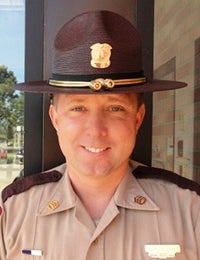Ask a Trooper: How to use emergency triangles if you break down on the highway
Published 8:45 pm Tuesday, February 15, 2022
|
Getting your Trinity Audio player ready...
|
Ask a Trooper by Troy Christianson
Question: Sometimes while I am traveling I’ve noticed a set of reflective triangles out behind a semi? Can I use those on my personal passenger car if it were to break down? Any advice is appreciated.
Answer: The best thing to do is make sure your vehicle is off the traveled portion of the highway and onto the shoulder. Then turn on your emergency flashers (hazard lights) so your vehicle is more visible to other motorists.
If you can safely display some type of emergency equipment, remember your personal safety. Other motorists might not be able to see you, so pay attention. High visibility reflective gear would be beneficial. If the roads are slippery and visibility is limited, it’s a very dangerous situation to be outside your vehicle.
If you drive a commercial vehicle, you’re required to carry three emergency triangles and place them in three locations during a stop. Emergency triangles must be placed within 10 minutes of stopping and should be kept in the passenger side box so they can be safely accessed and keep the driver away from traffic. Triangle placement locations may vary based on where the driver stopped. They are spaced out to ensure that other motorists can see the truck from a distance and change lanes or slow down.
Two lane (traffic in both directions and undivided highways)
• One triangle 100 feet in front of the vehicle, centered in the lane the vehicle occupies.
• One triangle 10 feet behind the vehicle on the traffic side of the vehicle.
• One triangle 100 feet behind the vehicle in the center of the lane the vehicle occupies.
Divided Highways and
One-Way Roads
• One triangle 10 feet behind the vehicle on the traffic side of the vehicle.
• One triangle 100 feet behind the vehicle in the center of the lane the vehicle occupies.
• One triangle 200 feet behind the vehicle in the center of the lane the vehicle occupies.
Obstructed View (hills and curves)
• If stopped on a two-lane road, place one triangle at least 100 ft. ahead of the vehicle.
• One triangle should be placed 10 feet behind the vehicle on the traffic side of the vehicle.
• Move the rearmost triangle between 100 feet and 500 feet back down the road to provide ample warning (the maximum distance from the vehicle shall not exceed 500 feet).
For the rest of the motoring public, if you see emergency triangles, flares, lights or other items, take note immediately and slow down. Be prepared to stop and drive accordingly.
You can avoid a ticket — and a crash — if you simply buckle up, drive at safe speeds, pay attention and always drive sober. Help us drive Minnesota toward zero Deaths.
If you have any questions concerning traffic-related laws or issues in Minnesota, send your questions to Sgt. Troy Christianson, Minnesota State Patrol, at 2900 48th St. NW, Rochester, MN 55901-5848; or reach him at Troy.Christianson@state.mn.us.


